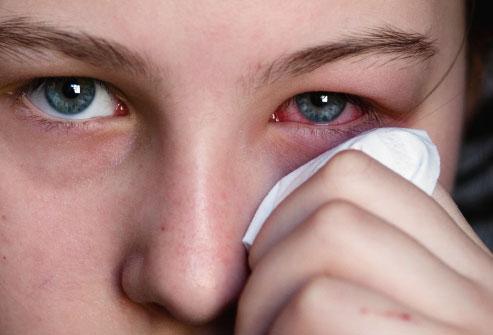Pink Eye: Everything You Need to Know
Pink eye is a general term used to refer to conjunctivitis. The word "conjunctivitis” can be broken down into "conjunctiva” (the membrane that covers the white of your eyes and the eyelid) and "itis” (the scientific method referring to inflammation). It is the inflammation which causes the blood vessels in the conjunctiva to become more prominent and cause the appearance of "pink eye”.
How Long Does Conjunctivitis Last?
1. Types of conjunctivitis
How long does pink eye last? It usually lasts for seven to ten days the majority of the time. There are quite a few things that determine how long a person suffers from pink eye. One of the major things dictating the persistence of the infection is which kind of conjunctivitis you are dealing with. There are several different kinds including:
- Bacterial conjunctivitis
A bacterial pink eye is by far the most common in form and can be caused by a long list of common bacteria including but not limited to Staphylococcus species, Streptococcus species, and Pseudomonas species. A thick, pus-like discharge is seen from the eye in almost all cases.
- Viral conjunctivitis
This is the most contagious kind of conjunctivitis because it is spread via the air. A simple sneeze or a cough is enough to spread the infection to someone else and the discharge from the eye is watery.
- Gonococcal and chlamydial conjunctivitis
This kind of conjunctivitis is related to organisms that cause sexually transmitted diseases. Most commonly, a baby being transmitted through the birth canal will contract this form of pink eye from an infected mother.
- Giant papillary conjunctivitis
People who wear soft contact lenses are usually affected by this kind of conjunctivitis. The condition can make wearing contact lenses difficult or may require a shift to a gas-permeable type of lens instead of the usual soft kind.
- Allergic conjunctivitis
The release of histamine caused by an allergic reaction is responsible for causing a series of changes in the body. One of those changes is itchiness and redness of the eyes. It is important to identify the allergen and minimize exposure to the chances of allergic conjunctivitis occurring are minimized.
- Non-infectious conjunctivitis
Atmospheric pollutants, external contaminants, or certain ingested ingredients can cause pink eye symptoms, but you can simply regard such symptoms as simply eye irritations.

2. The timeline of recovery
Distinguishing between the different kinds of conjunctivitis may not be an easy task since the symptoms can be very similar. However, it is still useful to make the attempt because the answer to "how long does pink eye last” is incomplete without actually knowing which kind of infection you're dealing with.
Viral pink eye usually lasts for about 7-14 days, the bacterial pink eye takes around 10 days to clear up, and other forms like allergic or non-infectious pink eye will last for as long as the irritant remains in close contact to the eyes.
The time is taken for pink eye to clear up also depends on the kind of treatment you receive. A bacterial pink eye will start to resolve within 24 hours of beginning antibiotics, whereas the same antibiotics will have no effect on the viral pink eye.
There are certain symptoms that should be taken seriously. If there is severe pain in the eye, extreme sensitivity to light, blurry vision, or the presence of an underlying systemic disease, your doctor must be consulted with as soon as possible.
Treatments and Prevention of Pink Eye
- Professional diagnosis and treatment
As mentioned earlier, the treatment of pink eye begins with the recognition of the symptoms and identifying the likely cause of the condition. Most doctors will start the treatment on the basis of clinical symptoms, but sometimes the discharge may be sent for testing or a "slit lamp” exam may be performed.
A bacterial pink eye is characterized by a thick, pus-like discharge present in one or both eyes and may cause swelling of the eyelids as well. Its treatment involves the use of antibiotic eye drops.
A viral pink eye will cause a lot more watery discharge, almost like tears. It will not respond to antibiotics and requires the use of antiviral eye drops containing antiviral medication. An allergic pink eye will also respond very quickly to eye drops containing antihistamines. Conjunctivitis caused by gonococcal and chlamydial infections must be treated with the appropriate antibiotics since trachoma (a form of chlamydia) can cause scarring on the surface of the eye and even lead to blindness.
- Preventive methods
Washing your hands regularly, avoiding school or other public contact until the symptoms have lessened in severity, using disposable wipes, washing out the eye regularly, not wearing contact lenses, washing your pillowcases and sheets in hot water, and not sharing makeup, towels, eye drops, or other such things will all help in preventing the spread of pink eye.
Allergic pink eye or non-infectious pink eye is not contagious and simply require the removal of the allergen or artificial contaminant for the pink eye to resolve.
The Final Word
Pink eye is harmless and self-limiting in most cases. All it requires are some common sense decisions to limit its spread and maybe some symptomatic treatment to make the patient feel better. This does not mean, however, that the conditions can be ignored.
A careful watch of the progression of the symptoms must be kept, and the doctor should be consulted in cases of any doubt. In rare conditions, pink eye may be a symptom of more serious underlying conditions such as blepharitis (dry eye), lupus, rheumatoid arthritis, Crohn's disease, or Kawasaki disease.
